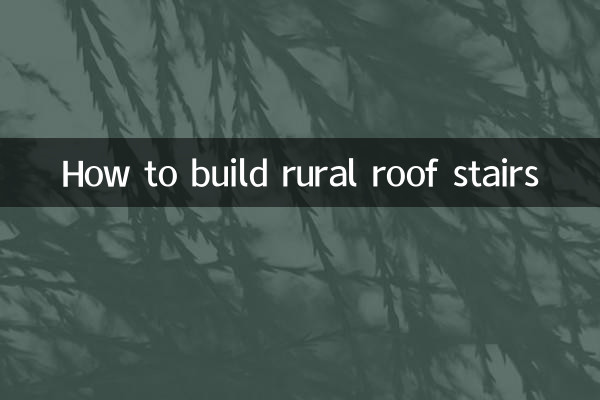How to build rural roof stairs: practical guide combined with hot topics
In recent years, with the rise of self-built houses in rural areas, the design and construction of roof stairs has become a hot topic. This article will combine the hot content of the entire Internet in the past 10 days to provide you with a structured guide to constructing rural roof stairs, covering key information such as material selection, construction steps, precautions, etc.
1. Recent hot topics and the trend of self-built houses in rural areas

| hot topics | Related content | heat index |
|---|---|---|
| rural revitalization policy | Rural Housing Renovation Subsidy | ★★★★☆ |
| Safety of self-built houses | stair structural stability | ★★★★★ |
| low cost building materials | Environmentally friendly masonry applications | ★★★☆☆ |
2. Comparison of common types of rural roof stairs
| Type | Advantages | Disadvantages | Cost (yuan/meter) |
|---|---|---|---|
| Brick-concrete structure | Stable and durable | Long construction period | 300-500 |
| steel structure | Quick installation | Requires anti-rust treatment | 400-700 |
| wooden structure | Beautiful and natural | Requires regular maintenance | 200-400 |
3. Detailed explanation of construction steps
1.Planning and design stage
Determine the location and slope of the stairs according to the purpose of the roof. It is generally recommended that the step height is 15-18cm and the width is 25-30cm. Reserve enough platform space to ensure safety.
2.Essentials of basic construction
The foundation needs to be compacted, and the thickness of the concrete foundation should be no less than 20cm. The steel structure needs to be embedded with connectors, and the brick-concrete structure needs to be waterproofed.
3.Main construction process
| steps | Technical requirements | Construction period (days) |
|---|---|---|
| Layout positioning | Error≤2cm | 0.5 |
| Foundation pouring | C25 concrete | 1-2 |
| Main body masonry | Verticality ≤3mm/m | 2-3 |
| Guardrail installation | Height≥90cm | 1 |
4. Safety precautions
• The steps need to be anti-slip. It is recommended to use anti-slip strips or anti-slip bricks.
• The width of the corner platform is not less than 80cm
• The distance between guardrails should not exceed 11cm to prevent children from falling.
• In northern areas, the impact of freezing and thawing needs to be considered, and the depth of the foundation should exceed the frozen soil layer
5. Maintenance suggestions
| Material | Inspection cycle | Maintenance points |
|---|---|---|
| concrete | once a year | Repair cracks and re-waterproof |
| Steel | Once every six months | Rust removal and touch-up paint |
| wood | quarterly inspection | Anti-corrosion treatment |
6. Recommendations for the latest building materials
According to recent industry hot spots, the following new materials deserve attention:
• Recycled environmentally friendly bricks: made from construction waste, reducing costs by 30%
• Nano waterproof coating: extend service life 2-3 times
• Precast concrete steps: construction efficiency increased by 50%
7. Frequently Asked Questions
Q: What should I do if the stairs take up indoor space?
A: Consider designing a spiral staircase or an external staircase to save 30%-40% of space.
Q: How to choose with limited budget?
A: We recommend the combination of brick-concrete foundation + wooden steps, which is both economical and durable.
Through the above structured data and detailed description, I hope it can help you better plan the construction of rural roof stairs. Always consult a construction professional before construction to ensure compliance with local building codes and safety standards.

check the details

check the details